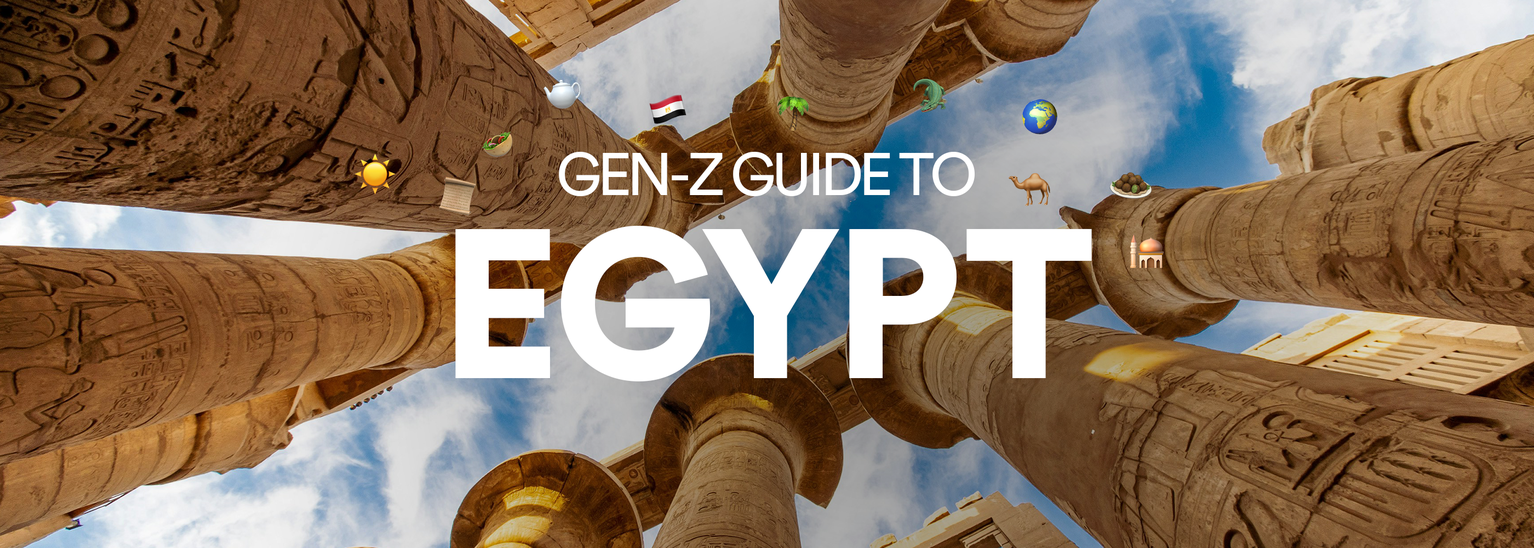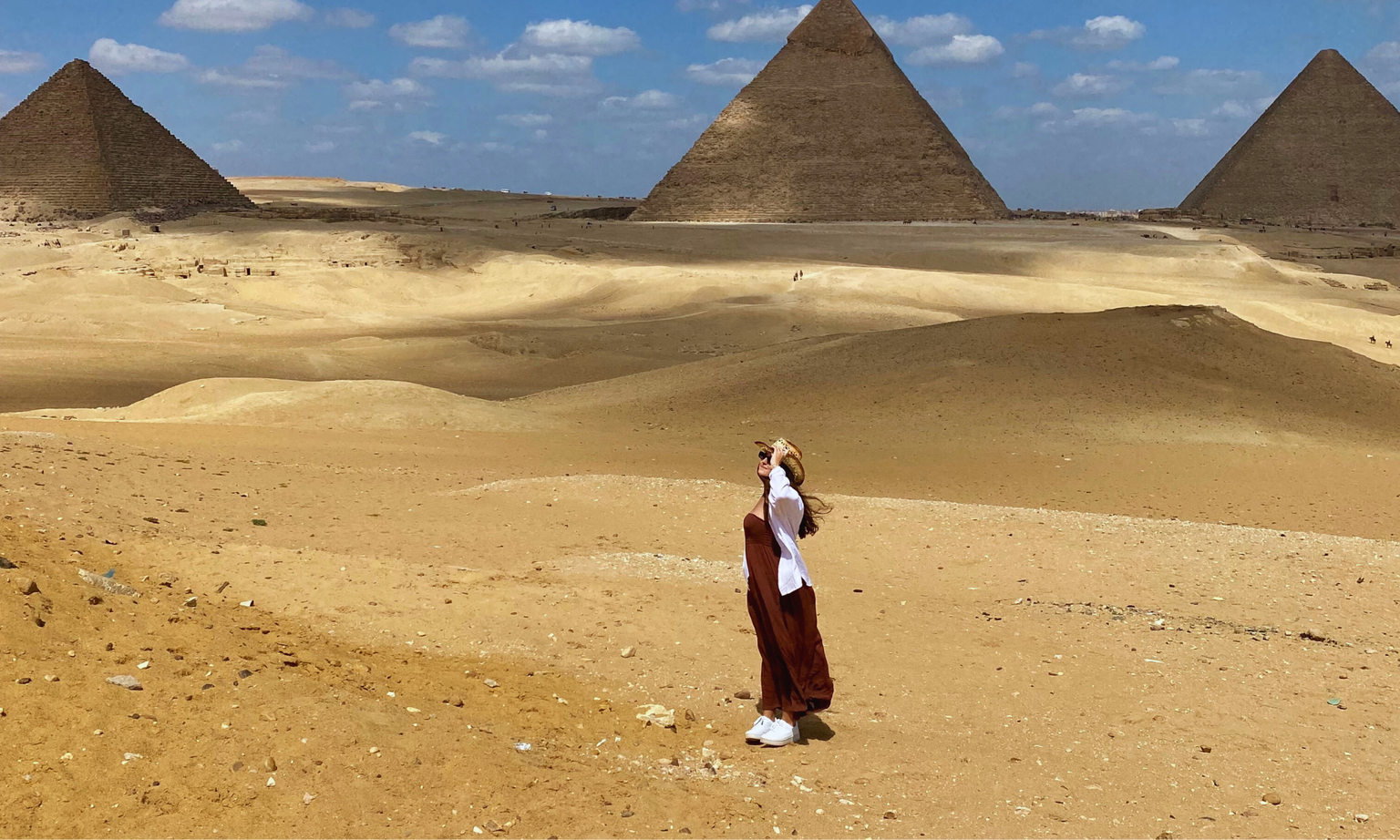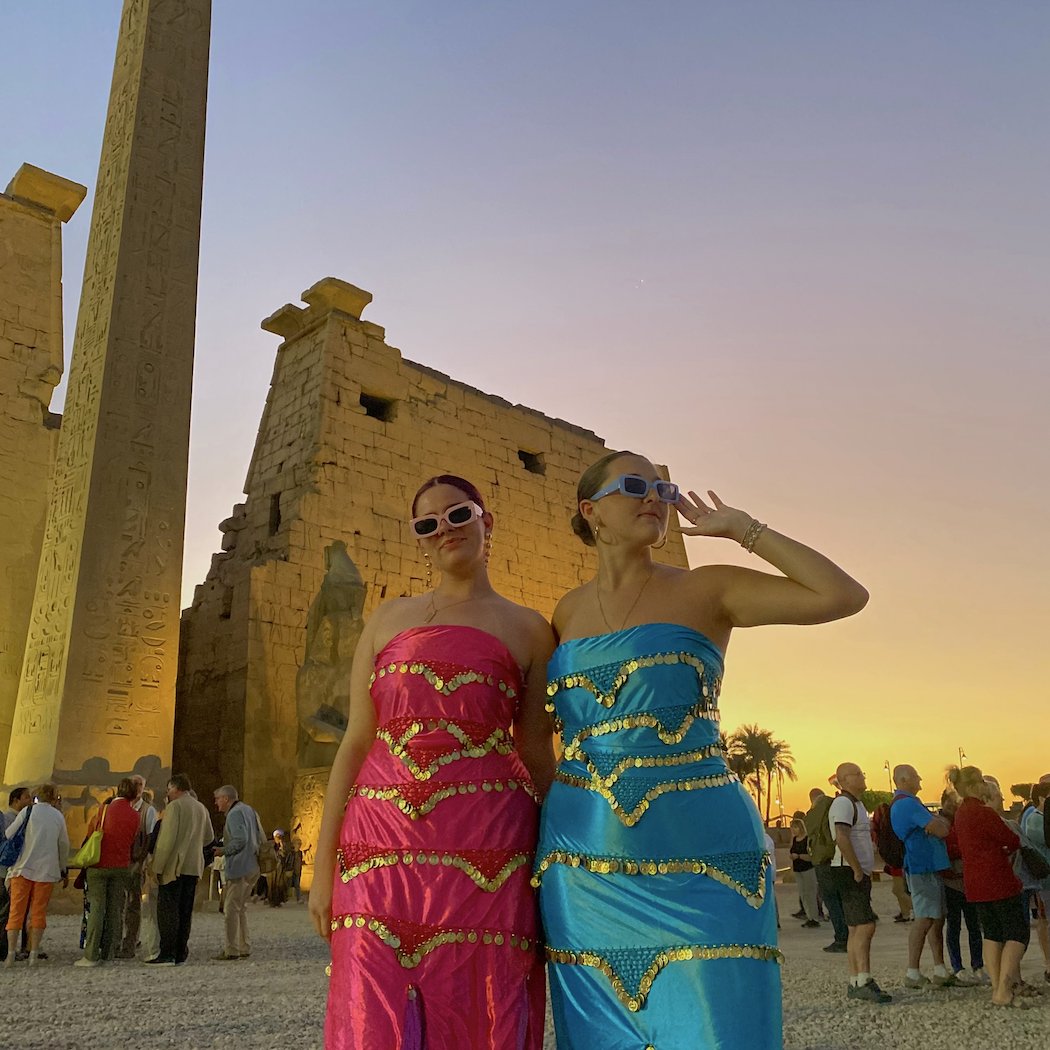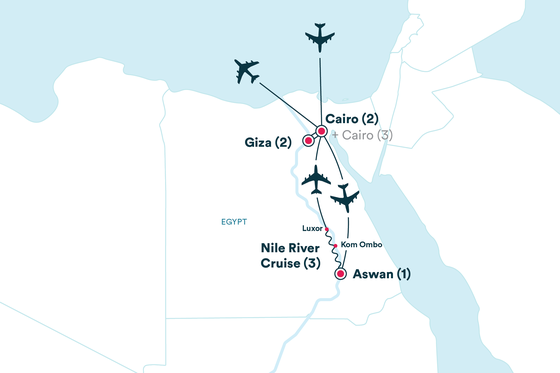
The Ultimate Gen-Z Guide to Egypt
Where to go, what to wear, what to eat, and what to experience in Egypt from two Gen Z-ers who love history (and read all of The Kane Chronicles).
So, you’ve booked your flight. You can practically taste the papyrus-printed souvenirs and hear the call to prayer echoing through ancient streets. You’re not just here for the Insta posts, Egypt is literally a living ancient world, and you’re about to live it all, like right now. Take it from two mythology nerds—you’re about to have the trip of a lifetime (and come back with an Anubis obsession, the girls that get it, get it). This is your no-BS guide to Egypt.

Cairo (the place you have always dreamed of going)
Cairo is probably the area of Egypt you’re most familiar with: pyramids, shopping, food, its all here. It’s the heartbeat of Egypt, mixing ancient wonders with modern chaos in the best way possible.
Think of it as your home base and starting point for your trip. It’s the city you will fly in and out of and a great jumping-off spot for the rest of your adventure. While you’re there, be sure to check out these sights...
- The Pyramids of Giza (obv the MVP). Let’s be real: the Pyramids of Giza are the reason Egypt still lives rent-free in all our minds. Standing on the desert sands, these colossal, 3D triangles are a testament to a different time, an entire other civilization. You’ll get your God-tier photo op here—and then proceed to wonder how humans even did that without drones or computers. (Did they?!)
- The Egyptian Museum. If there is one museum to go to on the entire planet it’s this one. It’s packed with artifacts: King Tut’s golden mask, statues, jewelry, and more. There is not a single replica in the museum, everything is original (except the Rosetta Stone…I’m looking at you England). It’s a little overwhelming because there’s just so much to see, but it’s one of those must-do stops. AND it just got redone and has a SICK view of the pyramids.
- Coptic Cairo. This is one of the oldest parts of the city and feels completely different from the busy streets that run through Cairo. You’ll find historic churches like the Hanging Church, narrow lanes, and even some Roman ruins. It’s a quiet area to walk around and soak in Egypt’s early Christian history.
- Mosque of Muhammad Ali. Up on the Citadel, this mosque is one of the city’s most recognizable landmarks. The inside is massive and beautifully designed, but the real win is the view—you can see all of Cairo stretched out below you. Definitely worth the climb.
- National Museum of Egyptian Civilization. The “civi museum,” as I like to call it. The big highlight is the Royal Mummies Hall, where you can see literal preserved pharaohs. It’s a great place to start if you want some background before visiting temples and tombs further south.
- Cairo Souk Market. Trade that desert dust for incense smoke and laughter—welcome to Cairo’s Souk Market. This layered labyrinth is where gold jewelry, hand-woven fabrics, and scented oils collide. Side note: negotiate like a pro (half price is usually where the magic starts). Total must-do when wondering where to go in Egypt if you're vibing for culture, souvenirs, and sensory overload.

Aswan (Let’s get on the Nile)
- Temple of Philae. This temple has huge ancient magical island vibes. You have to take a boat to get there, and once you do you will be standing in front of BOHEMOTHS (like miles high temples). This was one of the first temples we went to and one of the most gorgeous.
- Local Aswan market. Hit up a perfume-oil shop to geek out over frankincense and homegrown remedies that actually smell legit. They have literally any smell you want—even your favorite luxury perfumes. Ever wondered where they get all of their smells from? Now you know. And yes, we unfortunately guessed Dior Sauvage with one whiff.
- Aswan Felucca Sunset Sail. The day’s winding down and it’s too gorgeous to leave, so you don’t. Step onto a felucca, a traditional Egyptian sailboat, glide across the Nile at sunset, and let the breeze do its magical little thing. Soft pastel skies, rippling water, and maybe even a few story times with your new friends. If you’re lucky, you’ll play “bodies bodies bodies” and then you can REALLY say you’ve experienced death on the Nile.

Luxor (Land of the Temples)
Safe to say there is A LOT to see in Luxor. This is the land of dressing comfy AND cute (because you’re going to be getting a new killer temple pic every day).
- Luxor Temple: This is where we did our big slay with our outfits we bought at a gas station at a port on the Nile River cruise. Right in the middle of the city, Luxor Temple is massive and so incredibly unique—at night, it’s all lit up and looks stunning (plus, you can stargaze here). You can stroll the one-mile ceremony walk, aka Avenue of the Sphinxes, to the next temple, Karnak.
- Karnak. Just up the road from Luxor Temple, Karnak is on another level. It’s colossal: think towering columns, giant statues, and endless hieroglyphs. The Hypostyle Hall alone (with 134 massive columns) is worth the visit. It’s one of those places that makes you stop and just stare. This is the “colorful” temple, with original paintings still up on the pillars. Karnak is THE photo spot for that iconic “I’m in Egypt” post. Be sure to look up original images of the temple and look around incredulously at how color and art has survived THAT long.
- Sunrise hot air balloon ride in Luxor. Want that sunrise shot? Float above Luxor and the Valley of the Kings at dawn. Yes, it looks like a dream. Pro move: whisper "wow” in your head. You're welcome. Even the photos don’t do it justice.
- Valley of the Kings. This is where the pharaohs were buried—yes, including King Tut. You can actually step inside some of the tombs, which are covered in colorful hieroglyphs that still look vibrant thousands of years later. It feels surreal to walk through. As you descend into eerie tunnels, just tell yourself the chill is just the temperature and not any sort of curse.
- Temple of Queen Hatshepsut. Built into the cliffs, this temple looks different from most others in Egypt—very geometric and striking. Hatshepsut was one of the few female pharaohs, and her temple is as bold as her story.
- Colossi of Memnon. These are two gigantic stone statues that have been standing for over 3,000 years. They used to guard a temple that’s mostly gone now, but the statues themselves are still super impressive up close.
Related tours
The Nile River
The most famous river in the world and one you HAVE to see, and don’t worry you won’t see any crocs, thanks to the Aswan dam. There are no chompy animals in this part of Egypt’s Nile River, you’ll have to go south to see those!
- Nile River cruise. Pass the day lounging on deck by the pool, sipping on mint tea (or cappuccino with one brown sugar if you’re us) while the Nile floats past. For these nights, you're not just sightseeing—you're in it. Think temples lining the shores, sunsets filtering in between palm trees, and sitting in bed while daydreaming about Brendan Frascher and The Mummy. Maybe you’ll even cast some manifestation spells in the light of the super full moon like we did…who knows.
- Kom Ombo Crocodile Museum (mummies, literally). This is one of your stops on the Nile, but here's the twist: Kom Ombo isn’t just another temple drop, it’s two-temple-in-one and, unexpectedly, there’s a crocodile museum with actual mummified crocs. Like… ancient reptile fandom.

Dress code: What to wear in Egypt
Let’s talk what to wear in Egypt (because sunburns aren’t a good souvenir):
Lightweight, breathable layers: Linen or cotton tanks plus a shawl/knit poncho = your best desert-to-temple outfit.
Modesty is key: Think shoulders and knees covered, especially if you are going to churches and mosques. You can really wear whatever is comfortable, but you may get a few looks if you aren’t covered up outside of Cairo.
Comfortable (stylish) shoes: You’re walking a LOT… 20k steps is totally normal.
Sun protection gear: Wide-brim hat, sunnies, SPF, and definitely bring a water bottle.

“The cool girl (or guy)” souvenirs
A Cartouche: If you only get ONE thing in Egypt, let it be this. Egypt is probably the best place we have ever been when it comes to gold. There is a steep price on this souvenir, but it is one that will last a lifetime. You can customize them with hieroglyphics spelling out whatever you want! You can also get cheaper alternatives, like silver, gold-plated, brass, etc. Maybe even be like Emma and get “Slay” on one.
Perfume oils: The oils at the Frankincense shops are amazing. They have every scent you can think of, you can mix oils together to create your favorite scent, and get the cutest handmade glass perfume bottles that make the perfect gift. Some have medicinal and soothing properties, so don’t be afraid to grab one for sleep, one for the morning energy boost, and obviously the one for love—Queen of the Nile? We’ll take two.
Papyrus: SUCH a classic. You can find papyrus everything in Egypt, from bookmarks to postcards, there are tons of unique and authentic adaptations of classic papyrus.
Alabaster and pottery: Alabaster shops are of abundance in Egypt, and the people who own them are masters in their craft. You can find vases, statues, and so many other amazing souvenirs in these shops. You can also find “replicas,” which in Egypt is much more prestigious than a copy of something. A replica here is a recreation of something ancient, but has to be made by a certified, trained, replica artist to be able to be considered a “replica.” Alex’s favorite souvenir is a replica carving of the book of the dead.
Can't miss bites and sips
Koshari: This is a DELISH traditional dish typically made up of rice, pasta, and lentils with tomato sauce.
Hibiscus tea: The OG hibiscus refresher.
Zalabia: Small fried dough balls and traditionally in sugar syrup.
Feteer Meshaltet: Flaky, layered pastry traditionally served for breakfast. Amazing topped with honey, powdered sugar or, a favorite, Nutella.
Sahlab: Often described as “hot vanilla” it’s a warm thick sweet treat that you have to try at least once, especially if you’re a Red Pyramid fan.
Season forecast (spoiler alert—it’s always hot)
Summer (May–September): Extremely hot, intense sun, low humidity.
Winter (October–April): Manageable, but still with warmer temps.
Alright…book the trip!
Now that you have the insider’s guide to Egypt it’s time to pack that sunscreen, clear your SD cards, and get ready to check about 20 million things off your bucket list. And trust us, Egypt doesn’t do anything halfway.






























